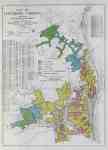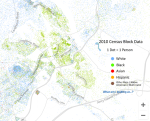So You Want Diversity in Your Community
I spoke at the Twin Oaks Communities Conference on Recruiting Diverse People to Intentional Communities. After my talk, I wrote down the key points and added references.
Description: Despite our best efforts, the intentional community movement in America is overwhelmingly white. In this workshop, we will explore the historical factors behind housing segregation and how it impacts where people of color choose to live. We will experiment with implicit bias and learn how it distorts our view of who would fit into an intentional community. Finally, we will discuss the best ways to overcome those internal and external factors to build truly diverse communities.
So You Want to Recruit Diverse People
Why? Children who grow up in diverse communities are more successful. Creating diverse spaces is a form of social justice. Diverse communities are more fun.
Barrier 1: Historical Housing Segregation
In the 1930s, the Home Owner’s Loan Corporation (HOLC) rated neighborhoods based on desirability. These ratings were based on explicitly racist ideas, including the idea that neighborhoods die as more black people move in. The FHA codified these ratings in their Underwriting Manual, which described what types of homes were eligible for mortgage insurance. As a result, the federal government prevented black families from owning homes unless they were in an “approved” area of the city. White neighborhoods fought tooth and nail to prevent black families from moving in because of lower home values associated with black families. When a black family could not get a mortgage insured by the FHA, they were forced to rent or take on expensive installment plans often offered by the Realtors themselves. This is directly tied to the disparity in wealth for black families versus white families to this day.
Another piece of housing segregation was restrictive covenants. These started after 1917 Supreme Court case outlawed cities from zoning based on race. Instead, people wrote in their deeds that the homeowner agreed not to rent or sell the home to a person of a different race. These covenants were outlawed in 1948, but their descendants are called Home Owner’s Associations.
Starting in the 70s, the federal government gave cities and counties money to tear down blighted areas of town in a process called urban renewal. These blighted areas were a result of overcrowding and poor upkeep in the redlined areas. Overcrowding happened when the FHA refused to insure mortgages for black families in the suburbs like they were doing for white families. These families were stuck in the inner city paying higher mortgage or rental costs, and they could not afford to maintain their homes. Cities took the opportunity to raze whole blocks and build new highways, shopping centers, and government complexes. They did not focus on building affordable housing for the displaced families.
This happened across the country and with the approval of multiple levels of government. To view redline maps of various cities, go to https://dsl.richmond.edu/panorama/redlining/. Compare the divisions around the city to the dot map that places people of various races around the country: https://demographics.virginia.edu/DotMap/. Redlining has had a substantial impact on where people live today. You can not recruit people to community without understanding that minorities have never had and still don’t have the freedom to move where they want to.


A few years ago, Fannie Mae sent testers of different races to realtors and banks to understand discrimination in the housing process.
African Americans and Latinos were:
-Shown fewer homes and told about fewer listings
-Asked more questions about their qualifications
-Steered to other communities, to lower priced homes or to open houses
-Required to provide 24 to 48 hours notice before viewing houses
-Quoted higher loan rates and offered fewer discounts on closing costs
On the other hand:
-White testers presumed more qualified
-White testers given greater access to properties
-White testers given more information
-White testers given lower loan rates, better discounts
-White testers more likely to succeed in home buying
This website is a great overview of the history of housing segregation: http://www.bostonfairhousing.org/timeline/1934-1968-FHA-Redlining.html
Barrier 2: Implicit Bias
We all have ideas about specific ethnic groups living in community: Black people have loud music, Southeast Asians cook spicy food, etc. Implicit bias is the act of creating a judgment at the lowest levels of our brain, below conscious thought. We make these judgments in a split second because human brains are not made to handle more than 100 connections at a time. We have a need to categorize things, and we do it with race. Bias is not good or bad. It is just our initial thought about something. We have a responsibility to examine our bias and understand whether we are making a decision based on facts or based on stereotypes.
When it comes to recruiting, we must think about how we see a person’s “fit” within the community. Are we assuming the vegan woman will fit in because she cares about the environment? Do we assume the church goers will be too religious to feel comfortable? Do we assume that this black man already has a community that meets his needs? Instead of making assumptions, we should get the know the people in front of us and evaluate them as a person, not a stereotype. In fact, the only way to overcome implicit bias is by being part of diverse communities and personally knowing people. And no, your one black friend doesn’t count.
Privilege Walk
Privilege is what we have based on our identities. It doesn’t say anything about us personally. It is the external world’s valuation of our lives based on factors we can’t control. Privilege is not good or bad either, but it affects how we move through the world. The privilege walk is based on an exercise like this one: https://edge.psu.edu/workshops/mc/power/privilegewalk.shtml.
Privilege Walk: Housing Edition
-If I want to, I can be in the company of people like me most of the time.
-If I need to move, I can be pretty sure of renting or purchasing housing in an area that I can afford and that I want to live in.
-The place where I grew up is not called run down, a slum, a ghetto, or a bad neighborhood.
-I can go into a grocery store and find the staple foods that fit with my culture.
-I can wear clothes that I feel comfortable in without having people question my choices.
-I have never asked a friend to call a realtor or landlord because I’m afraid I’ll sound “ethnic.”
-When I buy hair care products in a store, my shampoos and conditioners are in the aisle and section labeled ‘hair care’ and not in a separate section for ‘ethnic products.’
-I have not been rejected for a home loan and wondered if it was related to how people perceive my background, style of dress, accent, or hair style.
-When I talk about holidays and family celebrations, the people listening have experienced similar events.
-Policy decisions about my child’s school will be made by people who share our racial background.
Many white people feel guilt when they think about their privilege. Guilt is not a productive emotion. We all must recognize our privilege and actually work to correct situations where privilege is a factor. Affordable housing has been a way to help marginalized groups become homeowners. This makes sense because minorities are more likely to be paid less and have to pay more for housing. The approach is flawed, however, because Realtors and landowners still discriminate based on race. Section 8 is a program that pays for low income families to rent anywhere in a city. Studies have shown that landowners will outright say they have no space or refuse to show homes to Section 8 families.
How to Fix It
When it comes to recruiting, think about your networks. You are more likely to reach out to people like you, which means white families that are progressive and probably not religious. Expand your efforts to include churches, neighborhood centers, and other communities. Spend time with people who are not like you.
Ask permission from a person of color to get their feedback about your community. Not all people of color are willing to do this. Always ask if it’s ok to discuss it first. Do not go to your black friend, because undoubtedly they are a lot of people’s black friend and have heard the questions before. Find a community group or consultant that does work in the anti-racism space and pay them to educate you.
Make your commitment to anti-racism public. Talk about bias in your community. Learn more as a community. Have the difficult conversations, but don’t expect congratulations for it. Do the hard work because it’s the right thing to do.



